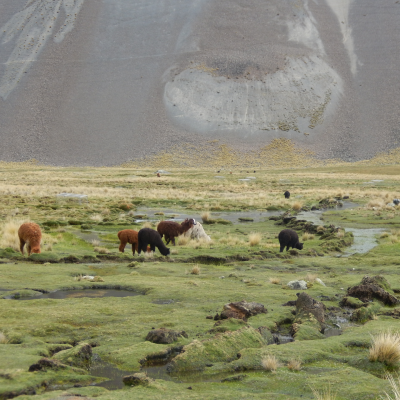Positive interactions in plant communities
Positive interactions, such as facilitation, have been greatly overlooked in ecology despite being ubiquitous across taxa (from bacteria to plants and vertebrates) and ecosystem types (terrestrial and aquatic). Species that create those positive interactions often do so by improving local environmental conditions, which often make them keystone or engineer species. The research interest around those positive interactions have lagged behind because, historically, competition and predation have been thought to be the main types of species interactions structuring communities and determining ecosystem functioning. During my PhD, I studied the effects of facilitation among plants on community assembly and ecosystem functioning through the lens of modern ecological theory, with experimental and theoretical approaches.
Facilitation effects on functional trait distribution

Nurse plants that have protection against grazing, for example by bearing thorns, often extend their protection to species growing in their vicinity or below their canopy (Anthelme & Michalet, 2009; Smit et al., 2007). This is the case of cushion plants found in the Cordillera Real of Bolivia, which provide forage for traditional livestock grazing by llamas and alpacas. With Fabien Anthelme and Rosa Isela Menenes from Herbario Nacional de Bolivia (La Paz, Bolivia), I have set up two field expeditions to collect in situ leaf traits and vegetation cover in a grazing exclusion experiment at 4500 m altitude near Titicaca lake. I used these data to show that facilitation against grazing (provided by the nurse plants) modifies the selective pressures on plant communities, which further determines the distribution of their functional traits. In particular, facilitated communities (i.e. those benefiting from grazing protection by a nurse) display more even distribution of functional traits (less dominance), and less trait overlap between species (more niche differentiation, Danet et al., 2017, 2018).
Our empirical results indicated that facilitation against grazing can enhance species coexistence by allowing non-grazing resistant phenotypes to persist in the community. I confirmed this intuition by developing a spatially-explicit theoretical model in collaboration with Florian Schneider and Sonia Kéfi, to show that this positive effect of protection against grazing by nurse plants generate stable coexistence between nurse and facilitated species over a large combination of environmental harshness and grazing pressure (Danet et al., 2020), making this type of interactions potentially relevant outside of arid or alpine systems.
Facilitation effects on ecosystem functioning and stability
Nurse plants can enhance environmental conditions and thus maintain higher biodiversity and biomass production in harsh environments, but the mechanisms behind this pattern have not been tested. In collaboration with Susana Bautista (University of Alicante), I set up an in situ experiment in Southeastern Spain, where I assembled 320 sapling communities with two levels of species richness (one or three species per community), in open space or under the canopy of a nurse plant, and manipulated water stress. We tracked the survival, biomass and measured in situ the leaf traits of the sapling communities over a year.
We found that facilitation occurred, but only for species-diverse communities in drought conditions, which produced more biomass mainly thanks to higher complementarity (Danet et al., 2024). Facilitation was revealed by showing that plants located under the canopy of a nurse had a functional trait profile typical of lower water stress (lower Leaf Dry Matter Content, higher Specific Leaf Area). Nurse plants were also found to modify the competitive hierarchy among species, as measured by selection effects, such that species that were the least competitive benefited the most from facilitation.
Those results suggest that nurse plants are crucial in maintaining species diversity and ecosystem functioning in harsh environments. These insights were tested in a theoretical model, which highlighted that nurse plants can reduce the likelihood of irreversible desertification in drylands (Danet et al., 2020).